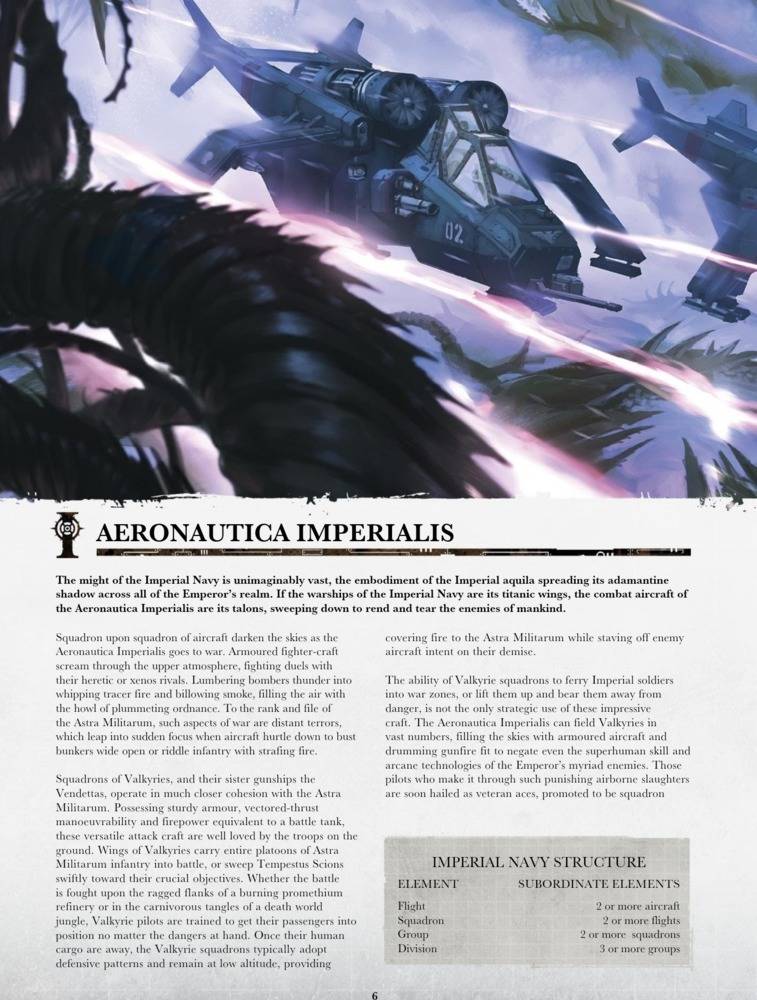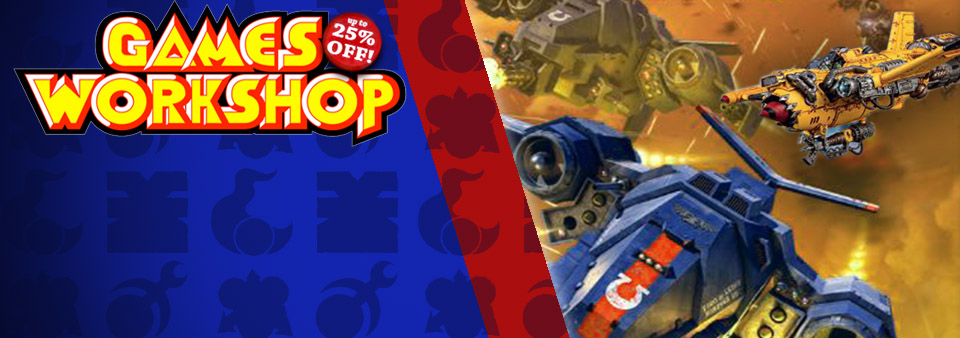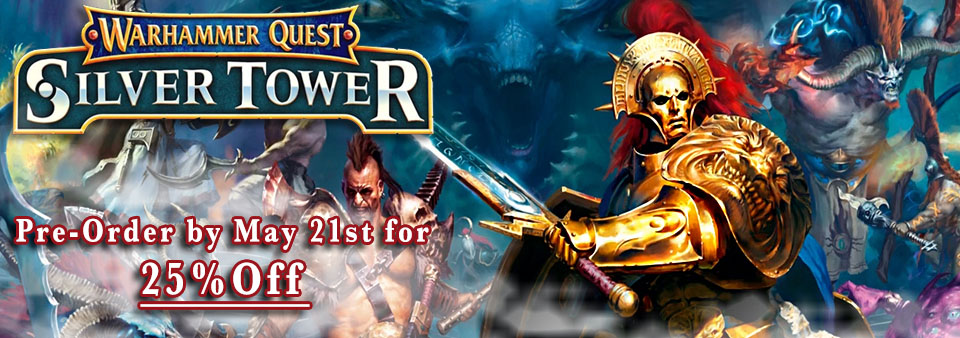40K: Death From the Skies, or Just Cake?


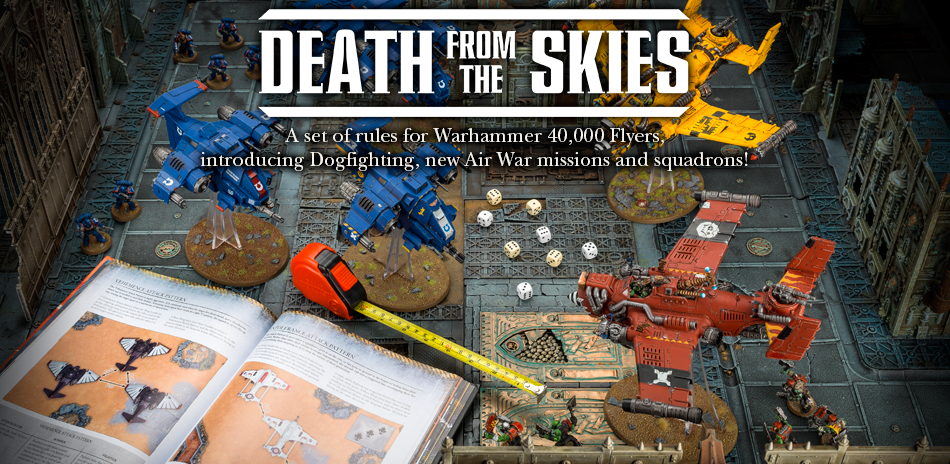
There’s a new flyer book in town, and it’s got enough rules in it to raise some eyes. But, can it cut it in tournaments? Guest article writer Abuse Puppy may have the answers!
Death From the Skies got its second edition this week- for those who didn’t know or had forgotten, there was a near-identical supplement released during 6th Edition with many of the same rules and options, albeit with some pretty significant tweaks and presented as an optional expansion. It never gained much traction for a number of reasons, so the new edition appears to be GW’s attempt to make a stronger push for its use (and thus also sales.)
The first thing to take note of is that Death From the Skies officially replaces the flyer rules in the BRB (as well as the datasheets in all of the relevant codices), by its own text. While mostly not all that different, there are a couple of pretty important rules in it that we’ll get into later that makes this a very big deal. Just as importantly, it means that players who don’t purchase the supplement will have access to incorrect rules in many cases- and that is problematic, because mandatory supplement releases are not something that I think we are particularly eager to see. It’s definitely one big strike against the book right from the start.
However, let’s go ahead and set that aside for the time being, as well as the history of DFtS while we evaluate the new book and try to take it on its own merits. The book is broken up into four main parts- a fluff chapter at the beginning, the new rules for flyers and dogfighting, the new section on flyer wings and attack patterns, and finally the updated datasheets and new formations for the various flyers.

Fluffy Bible
The first chunk of the book is, as usual, devoted not to rules but to background and images for the various races; the art is actually quite good in many cases, with lots of completely new full-color paintings and lots of dynamic page-and-a-half spreads showing off flyers in motion. And that’s all well and good, but unfortunately it seems to come at the cost of much actual descriptive text; every race gets a two-page section describing the organization of their air forces and how they operate (from where personnel are drawn, heirarchies, etc) but this text is extremely limited due to most of the pages being eaten up by the big, glossy art pieces. Since EVERY faction featured in the book gets such a spread , the first twenty pages or so are really just the same four paragraphs repeated over and over again as it describes how masterful and unbeatable every single race’s pilots are and how they are the very best in the whole galaxy, with just a small handful of pages of actual fluff that means anything quickly cut short.
The book then uses another thirty pages to have colored three-view pictures of various paint schemes that we get in every codex now- and while this sort of thing is okay as a reference here and there, I don’t need six pages of the same shot of a Stormhawk from different sides with the Ultramarines, Black Templars, and Imperial Fists colors on them followed by the exact same image of a Stormtalon instead with the same three chapters. It’s a rather frustrating waste.
The actual photos section, however, is a lot better; the ‘Eavy Metal team doesn’t do anything exceptional here, but they are all solid-looking pics that give some good looks at the various flyers and their details. One could certainly ask for more, but compared to the previous parts of this chapter it comes across as being surprisingly good.
All in all, DFtS continues the trend of the 7E books with regards to fluff- that is, more pics, more three-views, and less interesting text. I think this is pretty sad, as a lot of the stories in the 2E-5E codices were a huge part of what made the 40K universe feel compelling and drew players in to certain factions. Even the 6E books, while they made some missteps in places, added a ton more volume of detail and information compared to previous books and thus I think had some very real positives. Sadly, 7E appears to be moving away from all of that, and I think the game is worse off for its loss.

Only One Rule
The second chapter of the book is where we get into the real meat of things; it includes the updated rules for flyers and dogfights as well as attack formations, wing leaders, and the Altar of War missions. This is also where the book begins to become problematic (rather than merely vexing) and where, I think, the biggest issues with its acceptance for tournament play will lie.
The first big change is to flyer types; all flyers now have a subtype (or “role”) that dictates what they are good at. Attack Flyers are the most common type; they are designed to hammer ground targets and have no specific bonuses. Bombers are like Attack Flyers but worse- they almost universally have worse statlines and worse armaments as well as gaining worse formation benefits. Don’t let your kids grow up to be Bombers. Fighters are the air-superiority vehicles in the game now; only Fighters can choose to gain the Skyfire rule while on the table (the way all flyers used to be able to.) However, being more specialized than the other two, Fighters are worse against ground targets and suffer -1BS when shooting them.
(Of note: the distinction between ground targets and air targets is spelled out in the book, and it looks pretty familiar- anything you can shoot effectively with a skyfire weapon is an air target, but the list also appends Jetbikes to the list. However, the Skyfire rule itself remains unchanged, so don’t try shooting your Hydra at those Scat Packs or you’re gonna have a bad time.)
All flyers also have two new stats, Pursuit and Agility. Pursuit is how fast you are in a straight chase and adds to the maximum distance you can move when going Flat Out as well as doing some other niche things; it’s not actually a very useful stat. Agility, on the other hand, is how well you can turn and all flyers can attempt to make an extra 90 degree turn during their movement by rolling their Agility or less on a d6; as this is somewhat unreliable, you really can’t predicate your turn on it, but it does give them an option where they might otherwise have been sitting useless.
The really big change, though, is the Air Superiority rule. If one player has flyers in reserve and the other player does not, that player has Air Superiority and gains a +/-1 to their own reserve rolls (player’s choice) and penalizes all enemy reserves by -1. As this stacks with other modifiers and is essentially automatic, it means any kind of reserve-reliant army (such as Grey Knights, Drop Pods, or even just Eldar) is almost forced to have one or more flyers in order to keep the enemy from dominating them. It also means that flyers will normally arrive on a 2+ (rather than a 3+) since the dogfight phase typically means that any flyers in reserve will either kill the enemy there or die, and for some armies that had no way to gain a reserve bonus it can be a godsend- the bonus (or penalty) applies to all units, not just flyers.
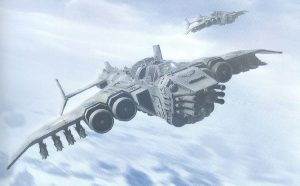
Flyer Wings
Flyer wings are the next part of the equation; they are, in some ways, “squads” of flyers and function as such. All flyers in the book can purchase additional models to form a wing in the same manner as most units would purchase a squad, but a flyer wing does not actually use the vehicle squadron rules. They do have to come onto the board in coherency the first time they arrive, but following that they are not required to maintain it nor are they limited in choosing targets, suffering damage results, etc, the way a true squadron would be. Flyer wings can each choose a Wing Leader, who gets one additional bonus off of a random chart; many of them are reasonably-significant (+1 BS against a type of target, 4+ to repair a hull point, etc) but none are completely overwhelming.
The much bigger part of being in a flyer wing is that they can assume attack patterns- essentially, particular placements on the battlefield in relation to each other that grant specific bonuses. All attack patterns have a position requirement (such as being directly to the side of one another, or in a diagonal line, or what have you) as well as a minimum number of models in the Wing to qualify (between two and four, depending.) The bonuses scale up as the number of models increases; three can get you Ignores Cover or Tank Hunter if you position right, four can get you Preferred Enemy for the remainder of the game or a 4++ and IWND. Ignores Cover is, of course, the one to really watch out for here, but since it requires careful positioning of models as well as maintaining all of them alive, I don’t think it’s going to be a game-breaker.
Dogfighting
Finally, we get to the dogfight phase. This is the biggest change to the rules, since it adds a whole new phase to the game, and not one that is particularly short, either. Of course, most armies will simply skip it because they, or the enemy, or both have no flyers. However, when you have to actually play it out it takes a fair chunk of time and can be rather annoying. The general gist is that during the dogfight phase all flyers in reserve engage in fights with each other and certain rock-paper-scissors type choices (as well as the Pursuit/Agility values of the vehicles involved) determine the exact sequence of things.
I won’t go through the full sequence of events because it’s actually not all that interesting, but essentially it has three steps- determining the range (modified by Pursuit), determining the angle of engagement (determined by Agility) and then finally shooting at each other (in which the choices previously determine whether a flyer shoots at normal BS or Snap Shots as well as which of the two models gets to shoot first.) Damage is resolved in the normal fashion (although models generally cannot Jink except in special circumstances); flyers that are destroyed can crash somewhere on the battlefield, depending on yet another random die result. Once the dogfight has been resolved (whether or not any models are destroyed) then the turn proceeds as normal- it is quite possible for a flyer to destroy an enemy in reserve during the dogfight phase and then succeed its reserve roll to come onto the field and act normally, including getting to fire again.
The air missions are… they’re not great. No, that’s giving them too much credit; they are, in fact, pretty bad. They range from Apocalypse-style shoot-em-ups where you can bring as many models as you want without regard for points to weird bombing-run missions to attempts to simulate an aerial massed battle. None of these are innately bad ideas of themselves, but they all suffer from one problem: 40K is not a good system to recreate air battles in, not even with the DFtS updates. Other systems that specialize in aerial combat have much more meaningful and useful rules for maneuvering, height and positional advantages, and the many other factors of combat in the wide-open sky. 40K, however, is a game of retro land combat- and its attempts to incorporate flying battles really just look sad more than anything. Not every system is (or should even try to be) good at everything, and I think that the air missions show just how much of a misstep trying to introduce this sort of thing as a major focus of 40K is.
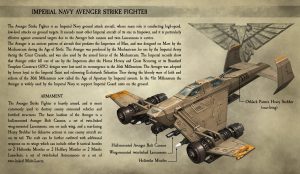
Wings of Steel
The final section of the book is the new datasheets and formations; it starts out with the Air Superiority detachment, which consists of between one and three flyer wings (each of which, as you’ll recall, must be at least two flyers.) All of the formations in the book are also considered flyer wings and can be included in the detachment as one or more of the three choices, though as with most detachments an Air Superiority detachment must draw all of its components from the same faction. The formation bonuses allow you to reroll one die during part of a dogfight and increases the bonus for having Air Superiority over your opponent (i.e. none of their flyers in reserve) to +/-2 to reserves on either side. You also can roll for all models in the detachment on a single reserve die and any transports in the detachment that can Hover have the Objective Secured rule. All in all it’s a reasonably useful detachment, though not a huge one- the reserve bonus/penalty is probably the biggest thing it does.
The updated datasheets are, for the most part, little different than their codex counterparts. There are, however, a few things to take note of in the book, either by their presence or absence. Imperial Guard, for example, features the Valkyrie but not the Vendetta- which strongly implies that the latter will not be making an appearance in the new Guard codex if and when it is released. The Stormraven (listed three times for its different factions) no longer has the ability to carry a Dreadnought- which seems like a pretty bizarre nerf on a vehicle that hardly needed it. Oh I see they hid it in the equipment section, exactly where you would think to look for a rule about transport capacity! The Nephelim Jetfighter’s missiles have a special rule that makes them better in dogfights (they essentially never snapfire), and the Sun Shark bomber still hasn’t remembered to bring its first Pulse Bomb along to the fight.
However, beyond the old units there are also a number of new units and formations, foremost of which is the Stormhawk. Built like a hybrid between a Stormtalon and a Stormraven, the ‘Hawk is a little bit tougher (Front AV12) and is a Fighter rather than an Attack Flyer (if you happen to be using those rules.) It lacks the Hover Mode and Strafing Run of its smaller cousin and its 15pts more expensive, but to compensate it comes with an extra gun- a two-shot Lascannon that can be replaced by a a three-shot Interceptor autocannon if you prefer. It also can reroll failed cover saves when Jinking, which is a very powerful defensive tool, but due to the model’s geometry it cannot spin the chin weapon to face hidden enemies the way the Stormtalon can. If you ignore the new DFtS rules for dogfights and flyer sub-types and all that I think it is potentially an even stronger flyer than the ‘Talon is; taking them in mind, it’s an excellent dogfighter but rather mediocre against ground targets and thus probably not worth the cost overall, though it’s still a long ways from horrible.
Space Marines get an update to the Storm Wing formation (1 Stormraven + 2 Stormtalons); it still gives Strafing Run to the Stormraven, but now the models can and must move an extra 12″ the first turn they arrive from reserve and enemies can only fire Snap Shots at them with Interceptor attacks. A pretty solid upgrade to them, although probably still not tournament-worth in the end. They also gain a new formation of two Stormhawks and two Stormtalons; the formation gets two Wing Leaders instead of just the normal one and can “split up” into two smaller wings or act as a single full-sized one as it prefers. Nothing particularly exciting, to be honest, but since it features some pretty good units it’s hard to complain too much.
Dark Angels similarly got a “two fighters one bomber” formation of their own, which gives the leader +1BS and +1 to Jink as long as you maintain a formation. It’s okay I guess?
Space Wolves get what is by far the most expensive of the formations, which necessitates two each of their two flyers (for a total of nearly 900pts) and gives Fleet to units that disembark from them as well as “freezing” any unit that suffers wounds from two or more Helfrost weapons. Freezing prevents them from making any kind of voluntary movement and reduces them to WS1, which are really powerful abilities but c’mon you guys it’s nine hundred points and you haven’t even put a model inside your transports or anything yet. And freezing the enemy requires causing at least two unsaved wounds to a unit, which against the units you really want to be freezing (MCs, GCs, deathstars) is pretty difficult to do. So I would rank it a solid “meh” despite the potentially-powerful abilities.
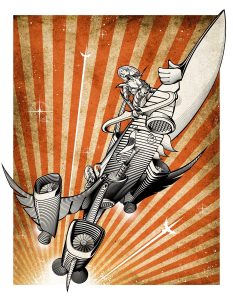
Dark Eldar also get a 2+2 formation for their vehicles, and since the Bomber is pretty bad (like all bombers, actually) that’s not a great start- and the formation bonuses are Interceptor for the fighters’ guns and Preferred Enemy against a single unit in the enemy army, so not really all that thrilling.
Craftworld Eldar, as usual, get a much better formation- though the presence of the Crimson Death in their codex already makes it somewhat questionable of a choice, though far from bad. 2-3 Crimson Hunters escorting a single Hemlock Wraithfighter make it up, and the Hemlock automatically knows Shrouding (from Telepathy) in addition to its other powers as well as adding +2 to Deny rolls for the Hunters if they are within 12″ of it. Decent, and Shrouding is a really good power that gives you just what you want, but the Crimson Death is a 4+ cover save all the time (instead of a 5+ so long as you cast Shrouding) and a reroll if you Jink (compared to a 2+ if you Jink.) Probably better overall, since it also gives bonuses against other airplanes; if the Shroud of Kuranous was two Hemlocks and one Hunter there might be a lot more reason to take it, but as it stands it seems like a solution in search of a problem.
Necrons also get a passable formation, which you may start to recognize as a theme in this book- passable, but not great. It rerolls 1s to wound and penetrate when shooting enemy HQs (how many HQ vehicles are there, really?) and once per turn can “pull” a single vehicle from reserve and Deep Strike it within 6″ of the formation without scattering. The idea of chaining this into a Monolith into another unit is pretty amusing, but probably not actually any good at the end of the day, as Doom Scythes just aren’t what they used to be now that their Death Ray is more of a Moderate Discomfort Ray.
Orks end up with yet another flyer on the same chassis as before; however, this one at least has enough guns to make its price tag look somewhat attractive. Its twin-linked main gun is actually pretty decent at putting AP2 wounds on things (and can be exchanged for a shorter-range one that can randomly Instant Death things for a token number of points- this gun also gets a bonus shot off of a Waagh turn, so is probably a good choice.) It also comes with another single-shot AP2 weapon and a 5++ save against one hit per turn and can upgrade to having an extra Supa-Shoota with Interceptor. They also get two formations, one of which is almost hilariously unusable (it requires three wings of flyers taken together) and the other of which is still four flyers, but at least has the decency to give them a way to get a 3++ save to mitigate their fragility.
Finally, we come to Tau, who not only get what are easily the worst flyers of the lot (both the Fighter and the Bomber) but also get the worst formation to go with them- it’s an updated version of the formation from their codex, which is pretty weak on its own, but the designers had the brilliant idea of actually making it worse by adding in an additional requirement for one of its abilities. So if any of you Tau players were thinking that maybe you might finally get thrown a bone with this supplement… nah, sorry. Ain’t happenin’.
If it seems like we’re forgetting something here, it’s because we are- Flying Monstrous Creatures, though talked about in several times as part of the book’s fluff sections, are not included or integrated into the rules in any way. If you are a Tyranid or Chaos Daemons player, you can go straight to hell and you can die, sir, because this book is not for you. Given how niche air combat in 40K is (and the fact that the previous book had rules for them), it seems odd that the new book would completely throw FMCs in the garbage- but there you have it, I suppose. Someone made an executive decision and several factions were just completely cut out of participation in this part of the game.
![]()
Death, or Cake?
So, we’ve seen what the book contains. Now we need to ask ourselves what it means.
As we mentioned at the beginning, Death From the Skies is technically not an optional supplement, as its rules replace those of the core rulebook. But, on the other hand, I also don’t think it will be a very popular supplement, because there is very little new in here- only Space Marines and Orks get new units, neither of which are blowouts, and the new formations for the various races are fairly underwhelming and not even particularly unique in most cases. So players don’t have a strong impetus to pick the book up to see cool new toys.
But what about the new rules? Well, the DFtS rules don’t actually really change or fix all that much with the flyer rules- they slightly mitigate the turn-radius and participation issues that flyers have in the game, but not in any kind of fundamental way. And the new flyer roles really don’t add much to the game, either- they just further fragment an already minimally-present unit subtype. (Remember, for example, that Sisters of Battle don’t even have a flyer of their own, nor do other minor factions such as Cult Mechanicus/Skitarii or Harlequins, and even major factions typically only have one or perhaps two flyers.)
Moreover, the Dogfight phase is not just slowing down a game that already has complaints about being far too slow already, especially compared to previous editions, but does so in a way that doesn’t actually add much enjoyment and isn’t really very intuitive or useful. The Dogfight rules are certainly better than air combat as it exists in the game now (i.e. “play chicken while shooting at each other”), but not by a tremendous margin and not by enough to warrant a nontrivial investment like the DFtS book is. No one seems to be all that excited about them, which is hardly surprising, so neither is there much of a push from the player base to use the rules. In fact, most of the people I have talked to- even tournament players- seem only passingly aware of the book’s release and were rather halfhearted about the whole subject.
Finally, we have the somewhat-arbitrary Air Superiority bonus/penalty, which is a major hindrance for any kind of reserve army. Again, this isn’t a big enough factor to be particularly crippling in itself, but combined with the numerous other factors that are working against DFtS, it doesn’t paint things a good picture. Reserves are a pretty important part of the game and many armies simply don’t have access to- or can get any real use of- flyers. Functionally mandating that such armies include a flyer if they don’t want to get screwed in the reserve game isn’t really fun or cinematic for anyone and just adds one more obnoxious thing to remember in the game.

So, what does the community think? Shall we pick Death From the Skies, with its new rules and fancy toys for flyers? Or shall we just keep our cake and leave things as it were? We’re certainly no stranger to ignoring GW’s bizarre rules missteps at this point- lord knows we’re dealing with enough of those already right now, what with Angels of Death and its psychic powers still looming over the game as a whole. For my part, while I like some of the ideas contained in the book I don’t think that it’s going to add much to the game and will result in far too many “gotcha!” moments for inexperienced players who show up to play a tournament (or pickup game) only to discover that someone has changed the rules when they weren’t looking and now their army doesn’t do what they thought it does. If GW had released the updated rules as a free supplement then perhaps (since it would be available and accessible to everyone), but as a mandatory hardback that players need to shell out for just to have the core rules of the game in addition to buying an already-expensive rulebook? I say no.
However, I realize my opinion isn’t universal or absolute- so what does everyone else think? For those that have read and tested the book, how does it play out? Is it really adding much to the game, or is it a waste of space?
~Certainly I’d like to hear, and I think that the Frontline staff would as well, since there are some major decisions to be made very soon and having a discussion prior to the potential votes can only do the community some good.

